We are developing the social individualist meta-context for the future. From the very serious to the extremely frivolous... lets see what is on the mind of the Samizdata people.
Samizdata, derived from Samizdat /n. - a system of clandestine publication of banned literature in the USSR [Russ.,= self-publishing house]
|
Probably the most important man of the 21st Century, if only for his potential to do good, Argentine President-elect (as I write) Javier Milei sat down with Tucker Carlson for an interview, (excerpt provided) at which he discussed the Pope, the murderous Castros and architecture amongst other points (that socialists are evil and think they are ‘God’). The interview was done with Mr Carlson asking questions in English and Señor Milei’s replies in Spanish are sub-titled (accurately I would add) and presumably interpreted in real time.
This segment is just over 9 minutes long, and it is well worth watching. We have all the indications that he is the real deal, he says that he is prepared to die for his beliefs, let us wish him a long and productive life and Presidency.
The story goes that Frank Lloyd Wright was once summoned to testify in a lawsuit. When he took the witness stand, a lawyer asked what his occupation was. He answered, “I am the world’s greatest architect.” Afterwards, his embarrassed wife told him he should be more modest. “You forget,” he replied. “I was under oath.”
– Timothy Sandefur, from his article: Frank Lloyd Wright: Rebel Architect.
Alice Coleman, geographer whose study of failed council estates impressed Mrs Thatcher – obituary
Alice Coleman, who has died aged 99, was a professor of geography at King’s College London whose book Utopia on Trial (1985), in which she launched a scathing attack on post-war high-rise housing estates, so impressed the prime minister Margaret Thatcher that she was given a five-year, £50 million contract to put her ideas into practice.
Her book, inspired by the American architect Oscar Newman’s seminal study Defensible Space: Crime Prevention Through Urban Design (1972), was based on a “design disadvantagement survey” in which she and a team of researchers surveyed blocks of flats, containing more than 100,000 dwellings in total, with the objective of mapping “lapses in civilised behaviour” (litter, graffiti, vandalism, pollution by excrement, and family breakdown leading to children being placed in care) against design features (number of floors per block, dwellings per block, dwellings per entrance, and so on).
She detected correlations between levels of crime and antisocial behaviour and the design of estates and, in her book, advanced the provocative thesis that badly-designed social housing schemes “breed antisocial people”. Change the design, she argued, and crime and antisocial behaviour would dramatically drop.
Le Corbusier’s vision of a “Radiant City” of tower blocks surrounded by parkland was, she wrote, the “great Utopian blunder”. Taken forward in Britain by an unholy alliance of planners and civil servants, it had been “conceived in compassion” but was “essentially a device for treating people like children, first by denying them the right to choose their own kind of housing, and then by choosing for them disastrous designs that create a needless sense of social failure”.
I saw Professor Coleman speak at a Libertarian Alliance event once. My memories of the time and place are foggy – late 1980s or early 1990s and somewhere near Holborn, I think – but I remember her and what she said very well. Not because she was a good speaker. On the contrary, she was difficult to hear and seemed nervous. But somehow that made her message all the more powerful. She was not there for fun; she was there to say things that urgently needed to be said. I still have the copy of Utopia on Trial that I bought that day.
The Telegraph obituary reports that not long after Margaret Thatcher’s downfall, Professor Coleman quit as an adviser to the government. Recalling the circumstances of her departure later, she said that civil servants “continually put obstacles in her path”, and that the new Environment Secretary, Michael Heseltine, did not wish to see any project with Margaret Thatcher’s name on it succeed. Given what happened after Brexit, I do not find either assertion hard to believe.
Nonetheless, I think the Telegraph obituary underestimates her influence and overestimates how much it mattered that she did not leave garlanded with flowers. As a quote attributed to both Harry Truman and Ronald Reagan goes, “It is amazing what you can accomplish if you do not care who gets the credit.” Some people contribute most to a cause by being the person who shifts the Overton Window. Alice Coleman moved the mainstream. Her achievement was to make her findings about the inhumanity of utopian architecture into background knowledge.
And how cool was this:
In 1960 Alice Coleman decided to update the national land-utilisation survey first conducted by Sir Dudley Stamp before the war, and recruited a team of some 3,000 volunteers to gather the information. With no funding available, she spent some £65,000 of her own money on the exercise. Although, due to lack of resources, less than 15 per cent of the country was covered with a published map, she reported some of the key results of her research.
Lewis Hamilton says he had ‘nothing to do’ with Mercedes deal with Grenfell firm
A little bit of background. A company called Kingspan sold some of the cladding that was largely responsible for the ferocity of the Grenfell Tower fire that killed 70 or so people. That same company now sponsors the Mercedes Formula 1 racing team. Kingspan themselves claim that their product was used illegally and without their knowledge.
There’s more. The government, unusefully, is poking its oar in:
Meanwhile, Communities Secretary Michael Gove said the government could amend advertising rules on racing cars if Mercedes does not pull the partnership with Kingspan.
The apparent rule being invoked here is that you should not receive money from a company that has supplied a product where the misuse of that product has led to someone’s death.
Oddly enough there is another company whose name appears on Mercedes’s cars that falls into the same category. That company is Mercedes. Mercedes makes cars. Rather a lot of people have misused Mercedes cars (and lorries) over the years and – guess what – lots of people have died.
It’s actually a bit worse than that. Mercedes is the result of a merger between Daimler and Benz. It is not entirely clear to me who invented the car but the choice comes down to one of those two. So – you could argue – not only are Mercedes responsible for Mercedes car deaths but every other car death as well. That’s millions of people (I think). So, if Mercedes should stop receiving sponsorship from Kingspan it should certainly stop receiving sponsorship from Mercedes. And probably from all its other sponsors. I am sure you could make an argument.
That is, of course, if the world wished to be consistent. But of course it doesn’t. Why not? We all know why. Well, if we don’t here’s a clue: a large proportion of the people killed in Grenfell Tower were black.
While I was imagining writing this – it sounded a lot better in my imagination than it looks on the screen – I had an uneasy thought: the late Brian Micklethwait would not pen a post like this. I wondered why. I told myself that Brian would continue to ask “Why?” “Why do we get this very apparent hypocrisy?” To which I suppose the answer is that in anything involving black people a different standard is applied. “Why is that?” I imagined Brian asking. At which point I started to come to some rather dark conclusions. Which is something Brian liked to avoid. “Optimism is a tactic.” as he once said.
On reflection, I don’t think he would tackle this subject at all. He didn’t particularly like discussing identity politics even if he did once use the phrase, “woke nonsense.” He also didn’t tend to accuse people of hypocrisy. Well, at least not strangers. So, I don’t think he would have written about this even if there hadn’t been an identitarian dimension. If he had I think the title would have been something along the lines of “Why black people (and everybody else) should want freedom for themselves (and everybody else).”
Our late colleague and friend Brian Micklethwait was very good at making people think. In particular he was very good at making me think, and even at times making me write. Often he would say something interesting that would make me write something as a response that I would never think to write for any other reason, and this blog, his own blog and its predecessors are full of articles and comments that were responses to things he started me thinking about. He had a tendency to repost my comments as articles when he found them particularly interesting, and many of our conversations took place in the articles and comment sections of various blogs. He loved posting photos of quirky things, fascinating objects, major pieces of architecture and engineering and interesting maps of places around the world that looked like they might be interesting.
Brian was not a great traveller. He was very pro-American, but he never visited the United States. He had done some travel earlier in life – including some behind the Iron Curtain before it fell, which I wish I had been able to do – but in the final two decades of his life when I knew him, he only ever really left London for regular summer trips to visit some friends in France. He clearly enjoyed this immensely, but travel was too much of a hassle for him unless there was warm hospitality as well as good company at the end of it.
He did, however, inspire me to travel. I saw photos of interesting things on his blog, and I researched them and wanted to go there, and I often did. He found this amusing, but he also liked to talk about what I had seen and photographed with me, so this continued the thoughts and conversations. (I still haven’t been on the Darjeeling Himalayan Railway, alas, although I have been on the similar but not quite as spectacular Matheran Hill Railway south of Mumbai).
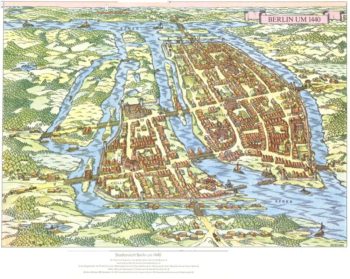
In any event, in March this year Brian posted a pictographic map of Berlin in 1440 that he knew nothing of the origins of Berlin, but that he found the map interesting, showing a town or small city on two islands in the river Spree with a third island on the left that was at not that point significantly populated. As it happened, I knew relatively little about the origins of Berlin either, but I was instantly curious. I have been to Berlin many times, but I couldn’t have told you where the original town was. (Actually Berlin was technically two towns at the time – Berlin on one island and Cölln on the other). So I researched it, and discovered that although Berlin had some medieval city walls, these had not protected the city well in the Thirty Years War. The relatively unfortified city had subsequently been fortified into a star fort between 1650 and 1683, at which time the two outer streams of the river surrounding the three islands had been turned into a moat and the inner banks replaced with high walls. These walls then subsided into the swamps on which Berlin was built and were torn down starting in 1734, after which the two outer streams of the river were filled in, leaving only one island. The route of the north-easterly wall/stream was eventually used as the route for the Stadtbahn – Berlin’s main east-west railway. The south-easterly route, well, it was filled in and replaced with a layout of streets. Where it was is not obvious on a map or in a photograph.
I also found some modern maps and photographs of Berlin, and sent them to Brian. The inner island, the Spreeinsel, is recognisably the same between the oldest map and the newest photo, and does still have some remnants of being the important centre, including Berlin’s protestant cathedral, but the northern half northern half of it became the site of Berlin’s greatest museums, many of which have been reconstructed in recent times and restored to something even beyond their pre-WWII glory. In the comments, further conversation ensued. More people got involved in the conversation.
Inevitably in all this, I booked a trip to Berlin to wander around and look at the city from this new (or old) perspective. This was originally booked for April 2021. This was optimistic on my part given the circumstances, but I have actually done a lot of optimistic booking of travel over the last 18 months, the vast bulk of which has subsequently been rebooked, postponed and/or cancelled. (Lots of things have been ludicrously cheap to book due to travel companies promising anything in return for being given even small amounts of money, and have then been deferred to the indefinite future. Hopefully these companies will not now go bankrupt when they are forced to catch up with their liabilities). In any event, this trip was postponed to this month.
And, well, on Friday October 15 I got on a plane having received the awful news earlier in the day that Brian had died that morning.
Trying to find old things in Berlin is a struggle. There was a fairly small town there in 1400, but since then it has been drained, expanded, made a provincial capital, rebuilt, fortified, invaded once or twice, expanded again, demolished, rebuilt again, expanded some more, fortified, rebuilt again and turned into an imperial capital, torn down, blown up, bombed to rubble, blown up some more, turned into a communist capital, demolished again, neglected, expanded some more and rebuilt again and made into a national capital, just giving he highlights. In most cities, the geographical and historical bones stick through. In Berlin, much less so. The watercourses to some extent, but that is all.
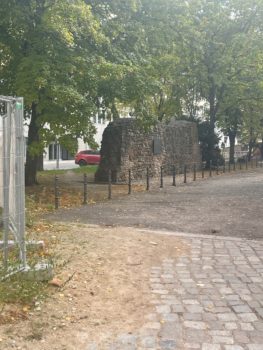
I attempted to look for remnants of the old city walls. In most cities it would be helpful to type “[City Name] wall remnants” into Google, but “Berlin Wall Remnants” gets something else. To make things even more complicated there was another wall, the Customs Wall, that was built around 1737 for tax collection purposes (boo). Most Berlin place names refereeing to gates (most notably the Brandenburg Gate) refer to this wall. So, I actually found myself looking at the original maps of Berlin in 1440 (and the later map of the star fortress in around 1683), looking carefully for the rights bends and branches and former branches of the river. I started well, finding a piece of (obviously restored) medieval city wall in Littenstrasse>. But that was it for finding further pieces of wall. I followed the approximate line of Littenstrasse through Alexanderplatz, just to the south of the Stadtbahn along the top of what had been Alt-Berlin.
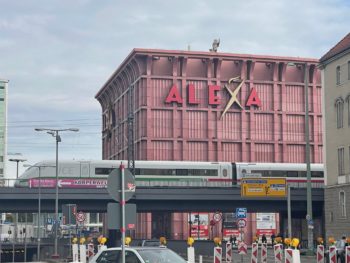
The street plan had been changed by the centuries and the Prussians and the fascists and the communists, and I found nothing more medieval. I crossed the Spree at Bodestrasse, between the Neues Museum (now again containing the bust of Nefertiti, as it did before 1939) and the Berliner Dom, the now restored protestant cathedral that had still been in post-WWII ruins when I first visited Berlin in 1992. I then doubled back to the top of the island before walking past the Humboldt University of Berlin, through Bebelplatz (site of the Nazis infamous book burnings), past the Roman Catholic St. Hedwig’s Cathedral (at present closed for the East German post-war modernist restoration to be removed and replaced with something more tasteful and less full of asbestos) and Oberwallstrasse, Niederwallstrasse, and Wallstrasssse, the latter three streets following the route (with a little straightening) of the wall of the star fortress, at least some of the bends in the shape of that wall being apparent. And back where I started, but on the other side of the river, having circumnavigated the old cities of Berlin and Cölln.
But there was one more thing to see. When we were looking at old and new pictures of Berlin, Brian’s cousin (I think) David Micklethwait commented that the only building that could be seen in the first, last, and intermediate pictures of Berlin was the Berliner Schloss (Berlin Palace), originally the Churfurstl Schloss (Elector’s Palace), home of the heads of House of Hohenzollern during their long journey from Margraves of Brandenburg to being Emperors of Germany before Kaiser Wilhelm II was forced to abdicate in 1918.
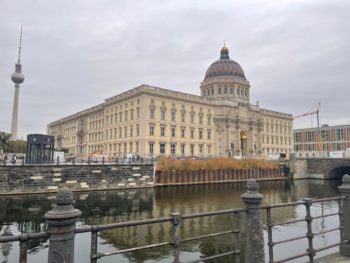
Except, I did some further research and it is stranger than that. Rather than being the oldest building in the later photo of Berlin, the Berliner Schloss is actually one of the very youngest – the current building was completed in 2020. The original building was badly but not irreparably damaged in World War 2. The East Germans at times used it as a backdrop for a War movie (including firing live ammunition at it), partly repaired it and used it as office space, denounced it as a symbol of Prussian militarism, and finally demolished it in 1950, partly for ideological reasons but mainly because they were arseholes. The Palace of the Republic – the East German parliament – was then built on the site. After German reunification in 1990, the new German government demolished this building, partly for ideological reasons and partly because it was full of asbestos.
After much discussion, the Palace was rebuilt as the Humboldt Forum, a museum featuring a reconstruction of the Berliner Schloss on the exterior but with an entirely modern interior. (The result was then denounced by the New York Times as an attempt to hide the history of Prussian militarism). Brian found this amusing, as it fitted in with another of his ideas – the triumph of modernism on the insides of buildings but not so much on the outside. His recent thoughts on this subject came in the context of hospitals, alas.
So, I finished my walk around old Berlin with a visit to the Berliner Schloss / Humboldt Forum. And, well, it’s weirder than that.
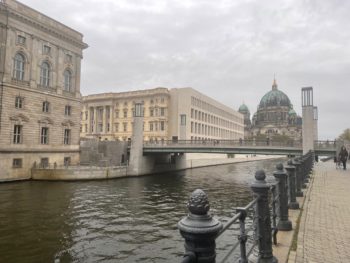
If you are going to reconstruct old buildings after a war, there are a few things you can do. You can take what is left, and use modern techniques and designs to rebuilt the rest, leaving you with a building that is half and half new and old. (Lots of buildings in Britain and for that matter in West Germany that were quickly rebuilt after WWII are like this). You can reconstruct the new parts in hopefully a sympathetic and complementary style, but also in such a way that the new bits are obviously new rather than old. (Much of the recent restorations of central Gdansk are like this, and I like them a lot). You can attempt to restore the damaged part of the building to the same design as before. The aforementioned Berliner Dom is an example of this. Or you can demolish the ruins and start again, either in the same style or differently. Rebuilding exactly what was there before (as was done in the centre of Warsaw) perhaps works if you do it right away (as the Poles did) but the longer you leave it, the more the result looks like trite and artificial, at least at first. (For an example, look at the Dresden Frauenkirche. It’s a brand new Baroque building with no wear built to modern health and safety standards)
And well, the architects who rebuilt the Berliner Schloss decided to make the fact that it is a reconstruction obvious, by building the front wall (including the main entrance) and two side walls as perfect reconstructions of the original down to every detail, but the back wall in a rather severe modernist style. Similarly, the main courtyard has three interior walls in the Prussian Baroque style of the original building and one in modernist wall. If you look at the building from the front or the sides, it looks like an (admittedly brand new) Prussian Baroque palace. From the back, it looks like a modernist building. From other angles, it looks mostly like an old building, but not quite.
Does it work? I’m not sure. It would have no chance of working anywhere other than in the strange city of Berlin, which is a mix of old and new and original and reconstructed and broken and repaired and has been a showcase of every German regime for the last 500 years – for good or for bad.
A month ago, and a year ago, and ten years ago, and twenty years ago, I would have talked about all this with Brian when I got back. I might have e-mailed him photos when I was still there. There would have been more sharing of photos and conversing and commenting on blogs. He might well have called me an idiot if I said something I disagreed with. I have no idea whether he would have liked or disliked the rebuilt Schloss Berlin, but he would have had something interesting to say about it. He loved talking about what buildings looked like in the context of the surrounds of the cities they were in, and found that too much architectural commentary didn’t focus on this and instead talked about buildings in isolation. I agreed with him on this point, which is one reason why I go places to see stuff.
Anyway, the point is that I miss Brian. Fuck cancer.
Brian Micklethwait has long observed that a company building a large new vanity HQ is highly corelated with the long march into decline 😀
That said, they have the world’s governments slaughtering their competition, so maybe wait a few years to go short.
Stop press: Continental Telegraph seems to be making the same observation.
I originally read this story about the striking off of the architect Peter Kellow by the Architects Registration Board (ARB) on page 19 of my paper copy of today’s Times. The headline reads “Architect struck off for Jewish ‘cult’ claim”. However an online search of the Times website yields no such story, and no mention of Peter Kellow. Strange. Fortunately, and embarrassingly for both papers, the Daily Mail version is almost word for word the same:
Award winning architect is struck off after he claimed Judaism is a ‘cult’ and called for ‘restraints’ to be placed on Jews who should be banned from holding public office
An award-winning architect has been struck off for claiming Judaism is not a race but a ‘cult’.
Cambridge-educated Peter Kellow called for ‘restraints’ to be placed on Jewish people including banning them from holding influential public office.
In a public Facebook post, he said there was ‘no such thing as the Jewish race’ and accused them of creating ‘resentment and suspicion’.
As a result of his behaviour, he was hauled before a disciplinary panel, found guilty of misconduct and kicked out of the profession after 47 years.
The Architects Registration Board hearing was told that Mr Kellow made the comments in April 2019, as then-Labour leader Jeremy Corbyn faced accusations of anti-Semitism.
He wrote: ‘There is no such thing as the Jewish race. This is one of the many stunts that Judaists have pulled on non-Judaists who have swallowed it whole. There is only the religion/cult of Judaism.
‘There is no doubt that Judaists have suffered from unfair and cruel treatment at many times in history but this was never racially motivated until the late nineteenth century and bloomed in the ideology of Adolf Hitler.
‘It is not far from the truth to say the Judaists were the inventors of European racism for they asserted they were racially different to the rest of us. Judaists have got themselves into a lot of trouble throughout history being subject to pogroms, ghettos and expulsions.
‘I am not saying this was justified, but why do we see this consistent pattern?
‘The problem people have and always have had with Judaism is not about race.. It is because Judaism is a cult.
‘What do I mean by a cult? A cult is a set of people, normally unified by a religion or quasi-religion, who try to create a society within the general society.
Mr Kellow also included freemasonry and Sunni Islam in his definition of cults.
He wrote: ‘Cults work against the interest of the general society as its members, in subscribing to a society within the society favour each other over the rest of us.
‘This naturally creates resentment and suspicion. How can you trust such people?’
‘How should society deal with people who through their cult activity weaken the bonds that the society needs to function well? We must put restraints on their ability to create a society within a society.’
Mr Kellow suggested creating a public register of Jewish people, banning them from public office ‘where they could discriminate’ between Jews and non-Jews and ban from being judges.
He also suggested banning Jewish faith schools and the wearing of religious clothing other than a skull gap.
The Times version really was amazingly similar, although it did say “skull cap” rather than “skull gap”.
You can read the original wording of the offending Facebook post on this archived version of the proceedings of the ARB disciplinary panel.
He began,
This business of “anti-semiticism” [sic] in the Labour party which is held up as racism. What is it all about really?
The Mail and the Times cite the most important points, but I thought it was worthwhile to quote Mr Kellow’s recommended policy towards what he calls “Judaists” and to believers in other religions that he deems to be cults:
First of all there is no question of banning them. I believe in freedom for the individual as a fundamental ideal and so if someone wishes to belong to a cult like Judaism or Freemasonry they must be free to do [sic]. But we must put restraints on their ability to create a society within a society. The main ones should be as follows
1. Registration of the cult in a public register
2. Registration of all adult members in a public register
3. No cult member can hold an important public office where they are in a position to descriminate [sic] between cult members and non-cult members. For instance it is totally unacceptable lo [sic] have a Freemason or Judaist as a judge as their decisions will very like [sic] work in favour of fellow cult members. Their strong bond in their society within the society will ensure this
4. Whereas adults are free to choose to belong to a cult, the same cannot reply [sic] to their children. The assumption that the children of cult members will be “born into” the cult is not acceptable in a civilised society. To this end, no cult can run its own “faith” schools
5. It must be against the law to wear cult clothing in public – except something worn on the top of the head like a hat [eg Sikh turbans or Judaist skull caps]. However, penalties will only be applied when a separate law [such as a driving evidence [sic] or bank robbery] is violated.
It is clear that Mr Kellow adheres to most of the usual tenets of twenty-first century Corbynite anti-semitism, given the customary veneer of progressive respectability by being anti several other religions as well – though he would have done better on that score to include Christianity in the list of “cults” to be restricted by law. To advocate that faith schools be banned is now fairly mainstream in left wing circles, and not only among them. The way he presented laws against Jews holding public office as being an anti-discrimination measure was clever. He only really slipped up by advocating that a register of Jews be compiled. That bright idea carried an overtone of Nazism too strong to ignore.
Peter Kellow has some nasty opinions. But should they stop him practising as an architect?
Asks the headline above this Guardian piece by Leslie Kern: Do cities have to be so sexist?
Let me ask a similar question: Do skyscrapers have to be so tall and yet so comparatively thin? Do skyscrapers have to be shaped, that is to say, like penises? The answer is: yes. That’s the whole point of skyscrapers. Their reason for existence is to fit a lot of floor space upon a very small patch of land, in a place where land is very expensive to buy because lots of people are needed to work in this one spot, and consequently where the elaborate technology needed to build them is justified by the advantages gained.
Says Leslie Kern:
From the physical to the metaphorical, the city is filled with reminders of masculine power. And yet we rarely talk of the urban landscape as an active participant in gender inequality. A building, no matter how phallic, isn’t actually misogynist, is it?
I’d say that the urban landscape is not actually that misogynist. After all, the basic economic fact that made female political, social and economic equality something which it made sense for women to demand was that the modern economy depends far less on physical labour done in fields and factories, and far more upon mental work, done in places like skyscrapers. Men are, on average, physically stronger than women, so in a world dependent on sweated labour, men were the dominant sex. But now, it counts for more that women have always been, again on average, just as clever as men, and rather more conscientious, while also being rather more biddable and risk-averse than men. Very useful corporate functionaries, in other words. How would all this new indoor and sexually more egalitarian mental labour have been accommodated in the exact places where it has been most needed, without the “urban landscape”, and in particular without skyscrapers? Instead of grumbling about skyscrapers, feminists ought to be glad about them. Even if skyscrapers are shaped like penises.
I once had an unpaid job in the office of the recently deceased and much lamented architect Ivor Smith. Much lamented, because even as I was, even way back then, beginning to have my doubts about his architecture, I had to acknowledge, and I say again now, that he was a lovely man, just as all the obituaries I have today been reading said he was.
One of my more vivid recollections of Ivor Smith was when he and some of his young colleagues were discussing a tower that some other architect had designed, and Smith speculated that this architect had done his design by slapping his cock down on the drawing board and drawing round it. Having only just stopped being a rather nerdy schoolboy, and having just become an equally nerdy student, I was a bit startled to hear a grown man in a suit and tie make a joke like this, in an office, as I think were some of the other architects. But there was as much masculine self-mockery in this joke as there was mere masculinity. Smith was no misogynist. I still remember also how much Smith’s wife and daughters adored him, and he them.
But then again, although I don’t know if this applies to Leslie Kern, many feminists don’t approve of happy families, any more than they approve of skyscrapers.
At least a few federal agency buildings could be greatly improved by the complete omission of entrances.
– Commenter Ferox
Robinson Meyer tweets:
If most Americans hate architectural abstraction and Mies-inspired modernism, then there’s still a compromise solution. It’s simple: All federal buildings should be designed in the style of India’s National Fisheries Development Board.
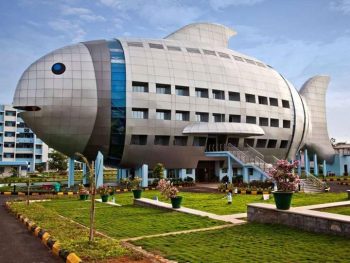
Trump has put architecture centre stage in the culture wars. Which will make it all much more interesting. Especially if more creature buildings are built, like the one in the picture above. And especially if they built something like a huge panda building or huge frog building, in Washington.
Eventually, there should be a giant building in Washington, the tallest in town, shaped like Donald Trump. A giant Trump sculpture. That would drain the swamp. They’d all flee in terror.
To be a bit more serious, but only a bit, just think about Trump’s edict, which says that from now on, all Federal Government buildings in the USA must be designed in the “classical” style. No more office blocks looking like multi-story car parks or international space stations. From now on, they’ll have to have a Parthenonic frontage stuck onto them.
Were any such buildings actually to get built, everyone who looks at one of these buildings is going to see … Trump. But all the people who work in government buildings hate Trump from the depths of their tax-dollar-sucking bossy-boots souls. So, they’ll make a huge stink to ensure that no such buildings ever get built. How beautiful is that? The governmental classes will, for the duration of Trump’s reign of architectural terror, expend huge amounts of energy opposing the expansion of the Federal Government.
The more I hear and see of Trump, the more I like him. But I’m talking about America, and what do I know about America? Luckily, we have plenty of commenters who do know about America, because they live there. Gentlemen, start your engines.
It’s now that time of the year between Christmas and the New Year, when we here sometimes do big postings with lots of photos. Usually, these have been retrospective looks back at the year nearly concluded. I did photo-postings like this in 2013, in 2015, and in 2017. And see also other such photo-postings here in the past, like this one in 2014, and this one way back in 2006.
We’re not the only ones doing these retro-postings about the nearly-gone year. A few days back an email incame from David Thompson, flagging up the posting he did summarising his 2019, which will already have been much read on account of Instapundit already having linked to it. And one of Thompson’s commenters mentioned a similar posting by Christopher Snowdon, mostly about politicians wanting to tell us what not to eat, drink or smoke.
So, here’s another 2019 retrospective. But it’s not a look back at the whole of 2019, merely a look back at a walk I took in London, on Christmas Day 2019. I like to photo-walk in London on Christmas Day, especially if the weather is as great as it was that Day.
I began my walk by going to Victoria Street and turning right, towards Westminster Abbey, where I did what I often do around Westminster Abbey. I photoed my fellow digital photographers, who were photoing Westminster Abbey:
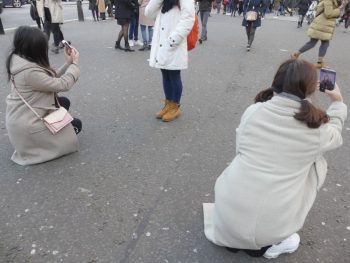
The lady on the left as we look is using one of those small but dedicated digital cameras, of the sort that nobody buys now and hardly anyone even uses now, because the logical thing, unless you want something like 25x zoom like I do, or really great photos that you could blow up and hang in an art gallery, is to use a mobile phone. But she is still using her tiny camera from about a decade ago. Odd.
Next some giant purple Christmas tree balls, outside the Queen Elizabeth II Conference Centre.
→ Continue reading: Looking back at Christmas Day
If you want to preserve a building, buy it.
– Stephen Green, in a short Instapundit post, linking to this piece about an attempt to preserve a “Tom’s Diner” whose owner wants to demolish it.
|
Who Are We? The Samizdata people are a bunch of sinister and heavily armed globalist illuminati who seek to infect the entire world with the values of personal liberty and several property. Amongst our many crimes is a sense of humour and the intermittent use of British spelling.
We are also a varied group made up of social individualists, classical liberals, whigs, libertarians, extropians, futurists, ‘Porcupines’, Karl Popper fetishists, recovering neo-conservatives, crazed Ayn Rand worshipers, over-caffeinated Virginia Postrel devotees, witty Frédéric Bastiat wannabes, cypherpunks, minarchists, kritarchists and wild-eyed anarcho-capitalists from Britain, North America, Australia and Europe.
|










